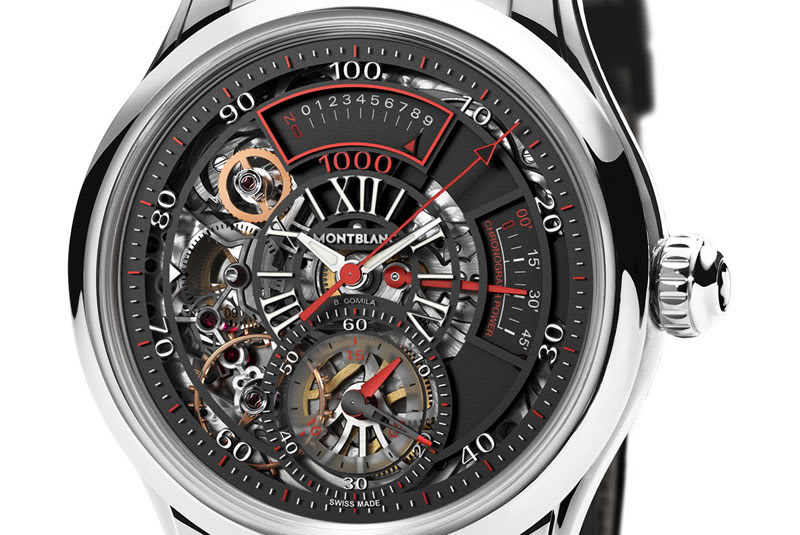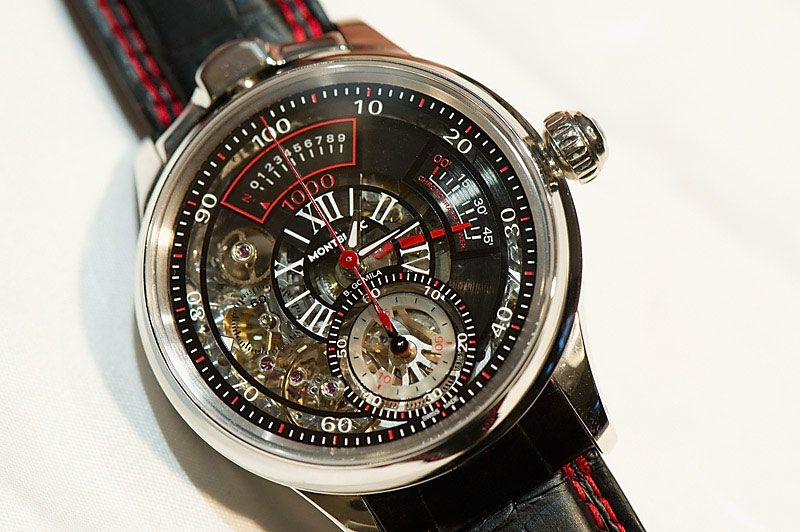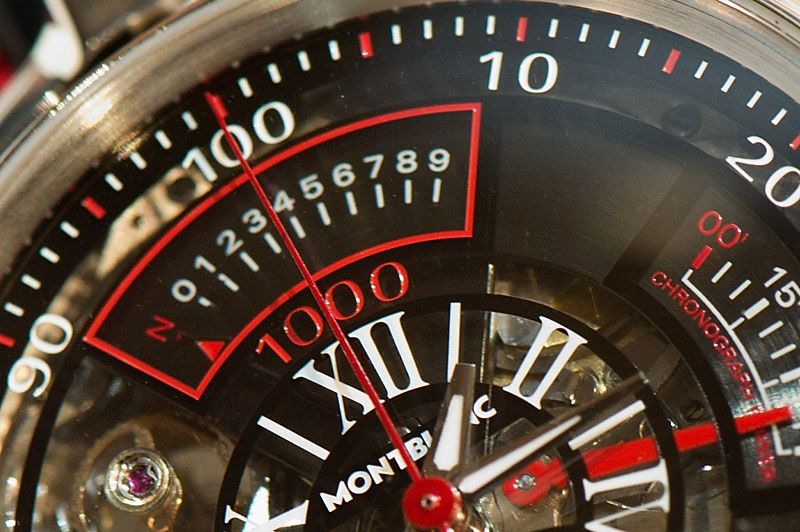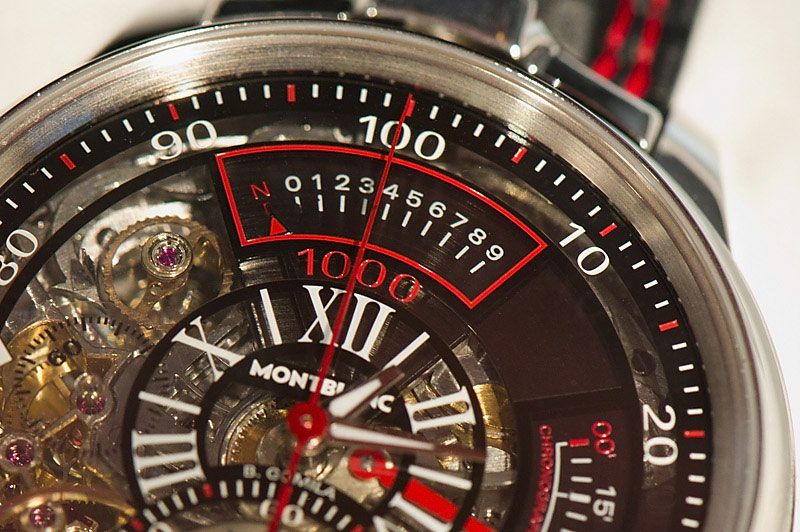Hands on with the Montblanc Timewriter II Bi-Fréquence 1000

The biggest novelty of Montblanc this year is the new Timewriter II. A bi-annual project that resulted in the Timewriter I, Metamorphosis, two years ago. This year it’s a chronograph again, but now one that can measure up to 1/1000th of a second.
The ‘Timewriter project’ is something Institut Minerva does together with a young watchmaker who does not have the opportunity to create his own idea, because he simply doesn’t have the resources. The Timewriter II is created in collaboration with Bartomeu Gomila and shows a new approach to measuring time to a precision of 1/1000th of a second.

How does it work? Let’s start with describing how the Timewriter II Bi-Fréquence is started and stopped. Like many chronographs produced in the Montblanc Manufacture in Villeret, the chronograph is operated by a mono-pusher. The pusher is not in the crown, but positioned on the top side of the case, above the 12 o’clock position. The crown is used for winding and setting (when pulled out) the watch. If the crown is turned counter-clockwise (when in the winding position), the mainspring for the chronograph function is being powered.
The time is displayed by the central hour and minute hand and can be read on the small concentric Roman hour markers. The real feat of the watch is of course the chronograph and reading the elapsed chronograph time has been given much attention in the design.

There are three positions that keep track of the recorded time, or actually four. The minutes and seconds are displayed on one axis at the 6 o’clock position; the seconds are displayed on the black ring with white and red markers and the minute counter records up to 15 minutes and can be read from the inner white circle.
The 1/100th seconds are indicated by the large red central seconds hand and can be read on the outside track that goes from 0 to 100. The 1/1000th seconds are indicated by the red arrow in the dashboard-like display. Once the chronograph is stopped the red arrow will jump from the N (neutral) position to the actual measured 1/1000th of a second.

And there is one more indicator to the right side of the dial. That is actually the power reserve indicator of the chronograph. Because of the incredible speed, this part of the movement uses a lot of power and the power reserve is limited to 45 minutes (which is actually a lot when compared to ‘the’ other chronograph that measures to 1/1000th). Since this indicator measures the power reserve very precise, it can also be used as a 45 minutes counter. If one wants to measure a longer time than 45 minutes, it’s possible to wind the chronograph while it’s running.
Yesterday I had the chance to talk with mr. Alexander Schmiedt, Director of Watches at Montblanc, and asked him to explain the Timewriter II Bi-Fréquence.
http://youtu.be/5CUwjOxOt6k
The name already indicates that this watch has two balances, each with a different frequency, hence Bi-Fréquence. The balance for the ‘normal time’, a classical screw balance with Philips terminal curve, has a diameter of 11,4 mm and vibrates at 18,000 semi-oscillations per hour (2.5 hertz). The other balance is for the chronograph and has a frequency of 360,000 (!!) semi-oscillations per hour (50 hertz). This is an incredibly high frequency and a large balance could not keep up with this kind of speed. Therefore the chronograph balance is much smaller, with a diameter of 6 mm.

Now the big question is of course how to measure 1/1000th of a second, while the ‘normal’ chronograph parts are able to measure up to 1/100th of a second. The Spanish watchmaker Bartomeu Gomila was inspired by a childhood memory: as a boy on the island of Menorca, Bartomeu loved to play with a big wooden hoop, which he would roll along the beach either by repeatedly pushing it with his hand or striking it with a little stick. He soon realized that he could keep the hoop rolling in a uniform rotary motion if he continually gave it equally strong impulses at equally timed intervals.
As Montblanc describes it: The secret was a balance with a frequency of 50 hertz (360,000 A/h). This rapid oscillator completes 100 to-and-from motions per second, i.e. 50 times in one direction and 50 times in the other. This tempo not only guides the motion of the trotteuse in the Montblanc TimeWriter II Chronographe Bi-Fréquence 1,000, it also sets the pace for delivering an impulse of energy that sets into rotation an innovative wheel in the gear-train, the so-called “thousandths wheel” (mobile de millième). Powered in this fashion, it rotates around its own axis at a uniform speed of ten rotations per second and thus provides the resolution with which hundredths of a second can be further subdivided into sets of ten increments. The chronograph function is controlled by a two-level column-wheel: one level guides the start, stop and zero-return functions; the other level controls the thousandths wheel.
This solution offers big advantages which make it far superior to every conventional mechanism that has ever been used to measure thousandths of seconds with the aid of a 500-hertz oscillating body. First of all, a frequency of just 50 hertz generates considerably less friction and drastically reduces wear. Furthermore the chronograph now has much more power reserve and this long-lasting power reserve also contributes to the regularity of the amplitude of the hundredths-of-a-second balance which, in turn, enhances the precision of the time measuring.

The movement itself is a piece of art, with beautifully designed bridges and simply gorgeous hand-finishing. The bridges are finished with Côte de Genève and beveled and the mainplate shows pèrlage. The picture above shows a rendering of what the finished movement will look like, when it’s ready. At the SIHH we got some hands-on time with a fully working prototype and we were very impressed by this concept of measuring time to a precision of 1/1000th of a second.
Copyright of the photos – Getty Images / Pascal Le Segretain




2 responses
HI,
Please give the price for this watch.
Very interesting√